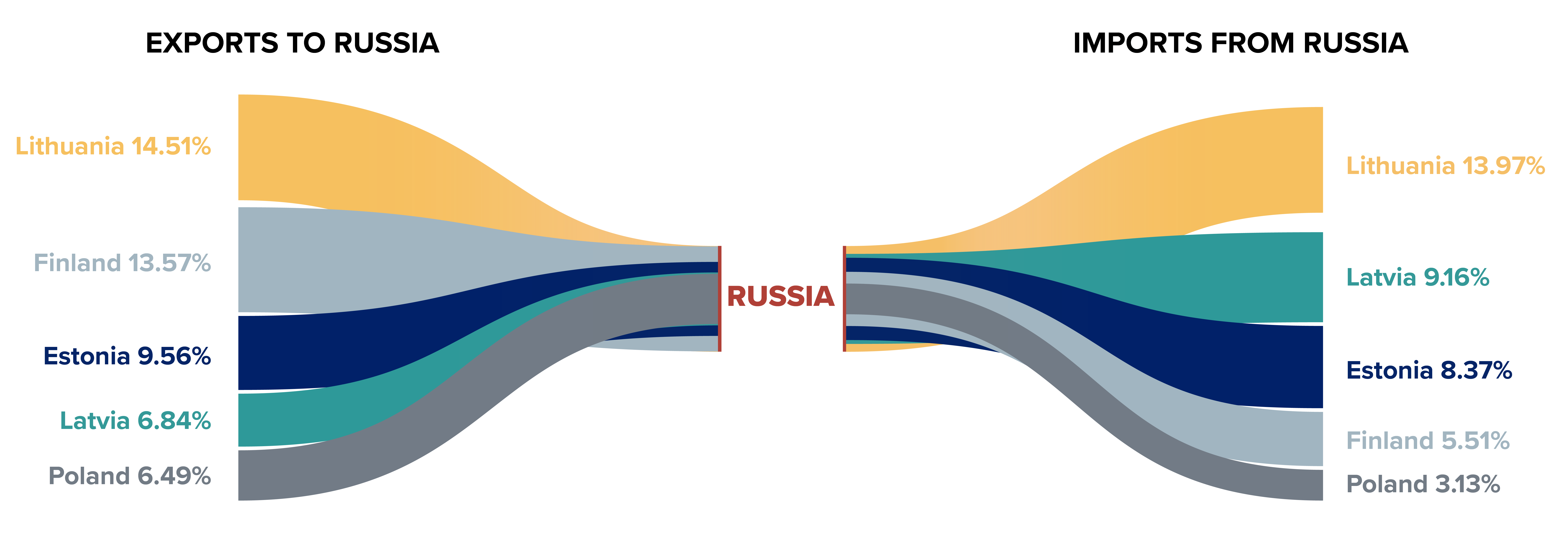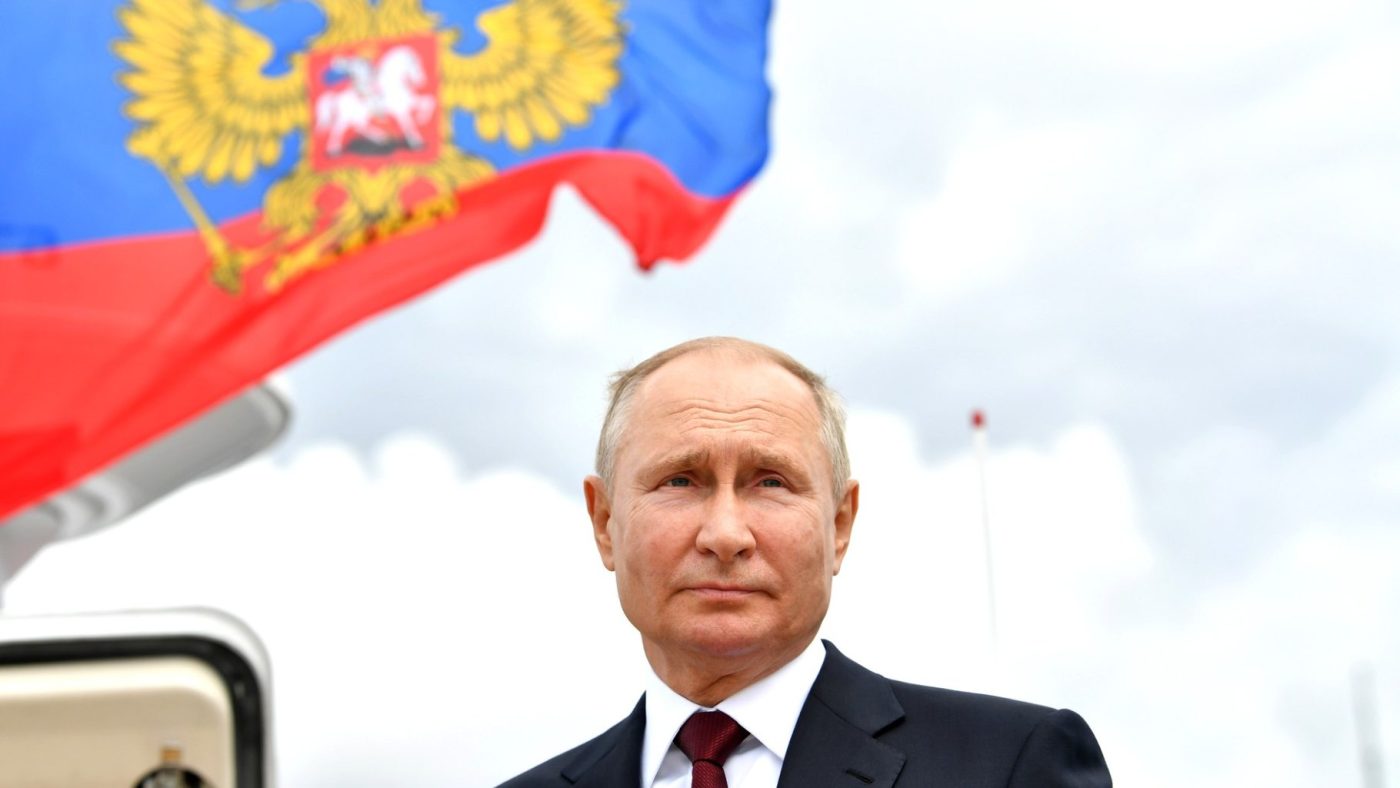This chapter is part of CEPA’s report on Baltic Sea Security Close to the Wind.
The Baltic Sea region is part of a wider landscape, ranging from the Arctic to the Black Sea, in which U.S.-led and other Western multilateral security organizations face challenges from Russia (and lately also China). This chapter outlines the strategic and geographical context for regional security. We then consider Russia’s aims, how these might be achieved, and assess countermeasures.
The United States and its allies are in the process of a contentious, protracted, and belated effort to assess and respond to the threats from Russia and China, amid disruptive economic, technological, and public health challenges. The success and failure of these efforts directly affect the security of the Baltic Sea region. The conceptual shift from the Panglossian “end of history” approach of the early 1990s to an appreciation of the threat from terrorism and rogue states, followed by an understanding that great-power competition has returned has been bumpy and incomplete; so too has the implementation of our response.
Perhaps most fundamentally, the short-term and profit-centered approach of business and financial decision-makers alongside national economic interests in the advanced industrialized democracies at times creates friction with national security interests. Seen through a national security lens, the West faces an existential struggle against determined adversaries: a stagnant but destructive Russian Federation and a rising China. But those in charge of the foundation of the West’s power — its economies — are still operating on a different basis. For business decision-makers, such considerations are secondary or irrelevant. They assume, so far correctly, that the political externalities (spillover costs) of commercial decisions can and will be borne by governments.

A prime example in the Baltic Sea region is the Russia-financed Nord Stream pipelines across the Baltic Sea. From a German point of view, it makes business sense to buy gas cheaply, reliably, and directly through a Russian-owned pipeline rather than deal with the technical and political problems of importing through Ukraine and other transit countries. From the point of view of European security, the question looks quite different. It is better to keep transit revenues flowing to Ukraine and to diversify gas imports, even at a higher cost, rather than entrench Germany’s dependence on Russia. This directly affects the security of the Baltic Sea region. Other examples abound, including Finland’s controversial nuclear power deals with Russia, the role of Chinese technology in next generation 5G data networks, and resilience in supply chains. This unresolved tension between perceived national economic considerations and national security priorities seriously harms the Baltic Sea region’s security.
Efforts to forge a transatlantic economic governance framework to deal with these and other challenges petered out during the Obama administration, when the Transatlantic Trade and Investment Partnership fell afoul of protectionist sentiment on both sides of the Atlantic. Since then, economic governance has, with some exceptions, fragmented further. One reason was the Trump administration’s “America First” approach. Another was Brexit. Though the Biden administration is avowedly multilateralist, it will take years to recover the ground lost during the past decade. This incoherent approach to international economic governance also seriously harms the Baltic Sea region’s security.
A further source of strain on multilateral and national cohesion has been the global pandemic. Unilateral, protectionist behavior by Western countries has corroded trust. Vaccine nationalism — preventing the export of vaccines and their ingredients — has disadvantaged smaller and poorer countries. The European Union’s role as rule-setter and rule-enforcer suffered a severe blow; health policy is the prerogative of national governments in the EU system, but where decision-makers in Brussels did have a role, their efforts, notably on vaccine development and distribution, were unsuccessful. Russia and China have exploited this disarray by providing their own vaccines, gaining prestige and gratitude in Latin American and African countries, as well as in Central Asia, the Caucasus, and the Western Balkans.
Arbitrary border closures in response to the covid-19 pandemic in the Baltic Sea region have had lasting effects on regional trust. Finland’s decision to close its sea border with Estonia in April 2020, despite a broadly similar epidemiological picture in both countries, dented Estonian perceptions of a special relationship with its only Finno-Ugric neighbor. Finland applied much laxer treatment to its western neighbor, Sweden. Finland also declined to join the “Baltic bubble” created by Estonia, Latvia, and Lithuania in May 2020.1 Poland’s abrupt decision to close its borders in March 2020 was an even bigger shock. Thousands of citizens from the Baltic states were stranded in Germany and other European countries. For those in the Baltic states, the three countries’ perilous peninsular status was underlined. Polish decision-makers initially seemed unaware of the issue, or unconcerned by it, prompting criticism from the EU and from the Estonian, Latvian, and Lithuanian governments.2

Leaving aside the specific costs of the pandemic on Western cohesion, the transatlantic relationship faces long-term problems. Failed wars in Afghanistan and Iraq and the excesses of the “global war on terror” corroded the legitimacy of U.S. leadership in many eyes, including in Europe. So too did the 2007-2008 financial crisis and its aftermath. During the Trump administration, a majority of German public opinion saw the U.S. president as the greatest threat to world peace — a greater danger than that posed by Russia or China.3 A Körber Foundation opinion poll in 2020 suggested that 82% of Germans would prefer to remain neutral in any new Cold War between the United States and China.4 Asked if they would back military action in support of a NATO ally attacked by Russia, 60% of Germans were opposed. European countries take a distant or even adversarial approach to U.S. policy on trade and technology.5 For its part, the United States faces pressure to reduce its overseas commitments in general and to deal with the rise of China in particular. This creates a double squeeze on the U.S. commitment to Europe.
Any weakening of the U.S. role would seriously harm the Baltic Sea region’s security. Yet overdependence has its dangers too. Put crudely, expecting the United States to carry too much of the burden for too long risks exhausting U.S. patience and tempting adversaries to test the U.S. commitment. Yet actively trying to substitute for the U.S. presence risks worsening the problem too. If decision-makers in Washington see that their efforts are not needed, they may be less inclined to make them.
These dilemmas have deep roots. New generations of decision-makers inevitably lack the personal and emotional bonds that their Cold War predecessors forged. The Obama administration abruptly cancelled planned missile defense installations in Poland and the Czech Republic, announcing the move on September 17, the anniversary of the Soviet invasion of Poland. Atlanticist politicians in both countries had expended political capital in backing the plans. In the Czech Republic, they paid for this with an electoral defeat. The same administration in 2011 announced its “pivot to Asia” and accelerated the U.S. military drawdown from Europe, with the last U.S. Army tanks leaving the continent in 2013. The transatlantic relationship came under increased strain during the Trump administration. U.S. President Donald J. Trump dismissed NATO as obsolete and called the EU an adversary. His personal unpopularity in Europe stoked anti-Americanism. Despite initial high hopes, the Biden administration has not enjoyed early success in its attempts to rally European support for its approach to China. Support for NATO among the U.S. public is lukewarm.6
Despite these difficulties, the transatlantic relationship remains durable and effective. It has heavy institutional ballast. NATO is the most successful military alliance in modern history. The transatlantic economic relationship is the strongest in the world:
- Total U.S. investment in the EU is three times higher than in all of Asia.
- EU investment in the United States is around eight times the amount of EU investment in India and China combined.
- The EU and the U.S. economies together account for about half the entire world GDP and for nearly a third of world trade flows.7

These economic ties underpin a deep U.S. interest in European security, however ungratefully or shortsightedly the beneficiaries of that relationship may seem to behave. Similarly, even Europeans who find the United States overbearing or self-centered would be hard pressed to explain how the continent’s security can be improved by weakening transatlantic ties. Indeed, though the EU may lag the United States in its strategic thinking, the days of outright complacency are over. The EU is at least on paper committed to treating China as a strategic rival. It promotes stronger defense cooperation among its members, particularly regarding procurement and military mobility.
EU-NATO cooperation in particular has improved radically since the alliance’s Warsaw Summit in 2016. The two multilateral bodies, which share 21 members, work together on issues including hybrid threats, resilience, capacity building, cyber defense, maritime security, military mobility, and counterterrorism. Progress is limited in some areas, but a work in progress is better than a work that is not in progress.8
Practical progress belies what can on both sides be misleading rhetoric. Though Europeans may yearn in the long run for what the French call “emancipation” from U.S. tutelage (and Americans may feel that it is high time that their allies shouldered more of the risks and costs of defense) even a more balanced relationship would still be based on cooperation, common values, and shared interests.
In short, it is strongly in the interests of all the countries of the Baltic Sea region that the EU:
- Develops a strong common security and defense policy.
- Aligns that policy as far as possible with the United States and with NATO.
The potential tension between these two objectives requires constant high-level attention by politicians and decision-makers in the region, complicated by the anomalous position of Norway (not an EU member), Denmark (which has an opt-out from EU foreign and defense policy), and Sweden and Finland, which are not NATO members but work closely with the alliance, and also have close ties with the United States.
The biggest strategic challenge facing the Baltic Sea region at the time of writing this report is from a country that has no coastline: Belarus. The outcome of Belarus’ current political crisis — pro-democracy protests driven by the 2020 fraudulent elections — is of prime strategic importance. It is possible, though unlikely, that Aliaksandr Lukashenka’s regime will splinter and fall, and that a pro-Western democratic successor government would be tolerated by the Kremlin. That would lead to a diminished Russian role in the region, further isolate Kaliningrad, enable new north-south infrastructure links such as a Baltic-Black Sea waterway that does not cross Russian territory, and provide extra strategic depth to NATO. These benefits make such an outcome highly implausible. All other outcomes would change the strategic landscape for the worse. If the Belarusian authorities win their war of attrition against the pro-democracy forces thanks to Russian help, the Kremlin will in return expect deeper economic, political, and military integration. This could include Russian military bases in Belarus, with potential consequences for both Ukraine (to the south) and NATO countries (to the west and north). A successful (from a Russian point of view) resolution of the Belarusian crisis would also provide Russian President Vladimir Putin with a badly needed dose of legitimizing popularity. At worst, a crackdown could lead to civil strife, economic dislocation, and large numbers of refugees.
Belarus Between: The Region’s Most Pressing Security Challenge
Lithuania and Poland share a common history with Belarus and the recent pro-democracy protests can be traced back to the ceremonial reinterment in November 2019 in Vilnius of a hero of the 1863 uprising against Tsarist rule.9 However, since the collapse of the Soviet Union, Belarus is the Kremlin’s closest ally, linked to Russia in a (so far mainly notional) “Union State” (also known as the Russian-Belarusian Union). This framework entrenches Russian military, security, and economic interests.
The most long-standing example of the regional security challenge presented by Belarus is the Astravets nuclear power plant: financed, designed, and built by Russia. When completed, this plant not only risks distorting the electricity market in the region by dumping cheap power and creating energy dependency on a Russian-controlled source. The plant was built — apparently deliberately — on the border with Lithuania, in an area of heightened seismic risk, and has been plagued by safety, management, transparency, and regulatory failings. Any leak of radioactivity (or even the announcement of a potential risk) would prompt a civil emergency in Lithuania, conceivably involving the evacuation of the capital, Vilnius, just 40 km (25 miles) away.10
In May 2021, Belarusian authorities forced a Ryanair airliner en route from Athens to Vilnius to land in Minsk, where two passengers, an exiled Belarusian opposition activist and his Russian girlfriend, were abducted. This operation took place on the direct orders of the Belarusian leader and belatedly drew international attention to the regime in Minsk’s rogue-state behavior.11
Belarusian intelligence operations are active and hostile in Lithuania, Latvia, and Poland. The authorities in Minsk harass Polish minority representatives as a part of a wider crackdown against pro-democracy and opposition forces.

The increased military integration of Russia and Belarus is a major destabilizing factor in Baltic Sea regional security. Though the two countries are nominally both sovereign states, their Kremlin-dominated “Union State” has a growing defense dimension. In March 2021, the two countries signed a five-year strategic partnership agreement, focusing on cooperation in air, airborne, air-defense, land, and special operations forces. Lukashenka backed the stationing of Russian aircraft in Belarus, while the two countries’ defense ministers announced plans for three joint training centers, in Hrodna (Grodno), Kaliningrad, and Nizhny Novgorod.
However, Russia’s military footprint in Belarus has long been substantial.12 Russia inherited two permanent Soviet-era military facilities in Belarus, an early warning radar system at Hantsavichy (Gantsevichi), and a submarine low-frequency radio communications station at Vileyka.13 Exercises such as Zapad and Shchit Soyuza (Union Shield), which each take place on a four-year rotation, and Slavic Brotherhood, provide a regular pretext for Russian deployments. In September 2020, Russia sent three battalions of paratroopers to Belarus for the Slavic Brotherhood exercise as well as Tu-160 strategic bombers and Tu-22M3 long-range bombers. One airborne tactical group landed, with equipment, at a training ground in Brest after a non-stop flight from Russia, signaling to NATO and to Belarusians how speedily Russian troops can arrive. It is also worth noting that the Slavic Brotherhood exercises were scaled up sixfold at short notice, with minimal transparency.14
Another worry is the increasing integration of Russian and Belarusian armed forces. Air and missile systems are already highly integrated and under Russian control. Russia will deploy S-400 air-defense systems in Belarus during this year’s Zapad exercise and could potentially leave them in place. This would create an arc of Russian Air and Missile Defense (AMD) capabilities between Kaliningrad and Belarus that would significantly limit NATO efforts to quickly gain air superiority and, therefore, mobility.15
The two countries have developed a dual basing concept in which Belarusian military and other infrastructure is adapted and modernized for Russian needs.16 Training focusses on interoperability between military and civil institutions, rear support services, and logistical structures. The British defense expert Keir Giles says that:
“Over and above the creeping normalization of Russian military activity in Belarus, which may morph into a semi-permanent presence, the clear message Russia is sending to NATO is that it can completely change the strategic position by delivering and inserting forces to those border regions with Belarus in a matter of hours.”17
Any Russian military or subthreshold action against the Baltic states or Poland would involve Belarus. The country also offers “plausible deniability” for manufactured grievances (for example, involving refugees, crime, or extremists) and other potential flashpoints.
- Kristi Raik, “The Coronavirus Crisis Has Brought New Realism to Estonian-Finnish Relations,” RKK ICDS, June 25, 2020, https://icds.ee/en/the-coronavirus-crisis-has-brought-new-realism-to-estonian-finnish-relations/. [↩]
- “Baltic states send ships for citizens stranded on German-Polish border,” Reuters, March 17, 2020 https://www.reuters.com/article/us-health-coronavirus-baltics-idUSKBN2143NE. [↩]
- Zach Budryk, “Germans think Trump is more dangerous to world peace than Kim Jong Un and Putin: survey,” The Hill, December 26, 2019, https://thehill.com/blogs/blog-briefing-room/news/475998-germans-think-trump-is-more-dangerous-to-world-peace-than-kim. [↩]
- “Germany’s painful wriggle between China and the US: Navigating between the powers has become a headache for Berlin,” Nikkei Asia, December 28, 2020, https://asia.nikkei.com/Opinion/Germany-s-painful-wriggle-between-China-and-the-US. [↩]
- Jacob Poushter and Mara Mordecai, “Americans and Germans Differ in Their Views of Each Other and the World: Differences especially stark on defense spending and security issues,” Pew Research, March 9, 2020, https://www.pewresearch.org/global/2020/03/09/americans-and-germans-differ-in-their-views-of-each-other-and-the-world/. [↩]
- Linley Sanders, “How does America feel about NATO? Support for alliance falls across key Western nations,” YouGovAmerica, April 4, 2019, https://today.yougov.com/topics/politics/articles-reports/2019/04/04/how-does-america-feel-about-nato. [↩]
- “Countries and Regions: United States,” European Commission, Last update: June 21, 2021, https://ec.europa.eu/trade/policy/countries-and-regions/countries/united-states/index_en.htm. [↩]
- “Relations with the European Union,” NATO, June 21, 2021, https://www.nato.int/cps/en/natohq/topics_49217.htm. [↩]
- Wincenty Konstanty Kalinowski, also known as Vincent Kanstancin Kalino?ski in Belarusian, Konstanty Kalinowski (Polish) and Konstantinas Kalinauskas (Lithuanian). See Konstanty Kalinowski, Wikipedia, https://en.wikipedia.org/wiki/Konstanty_Kalinowski. [↩]
- Alberto Nardelli, Nikos Chrysoloras, and Milda Seputyte, “Atomic Plant at EU’s Border Spooks Leaders Amid Risk Warning,” Bloomberg, December 10, 2020, https://www.bloomberg.com/news/articles/2020-12-10/nuclear-plant-at-eu-s-border-spooks-leaders-amid-risk-warnings. [↩]
- “EU, NATO Demand Belarus Explain ‘Forcible’ Diversion Of Passenger Plane, Detention Of Journalist,” RFE/RL, May 23, 2021, https://www.rferl.org/a/belarus-raman-pratasevich-ryanair-false-bomb-threat/31269351.html. [↩]
- Nicholas J. Myers, “Russia’s Union Shield Exercises—in Transition?”, Jamestown Foundation, September 24, 2019, https://jamestown.org/program/russias-union-shield-exercises-in-transition/. [↩]
- Yahor Lebiadok “The Slavic brotherhood’s future,” Meduza, October 2020, https://meduza.io/en/feature/2020/10/16/the-slavic-brotherhood-s-future. [↩]
- Arvydas Anusauskas, “Lithuania’s defense minister: Mission accomplished? Not yet,” DefenseNews, January 11, 2021, https://www.defensenews.com/outlook/2021/01/11/lithuanias-defense-minister-mission-accomplished-not-yet/. [↩]
- Mark Episkopos, “Russia’s S-400 Is Encroaching On NATO Territory,” Yahoo News, June 9, 2020, https://news.yahoo.com/russias-400-encroaching-nato-territory-090000733.html. [↩]
- Решение Высшего Совета Сообщества Беларуси и России от 02.04.1997 N 5. „Об Общих принципах военного строительства и использования элементов военной инфраструктуры Беларуси и России“,Решение № 4 Высшего Совета Союза Беларуси и России. О Концепции совместной оборонной политики Беларуси и России, http://www.conventions.ru/view_base.php?id=14630 [accessed on 02/03/2018]. [↩]
- Tony Wesolowsky, “Russian Military Creep in Belarus Raises Security Alarms,” RFE/RL, October 4, 2020, https://www.rferl.org/a/russian-military-creep-in-belarus-raises-security-alarms/30874178.html. [↩]





